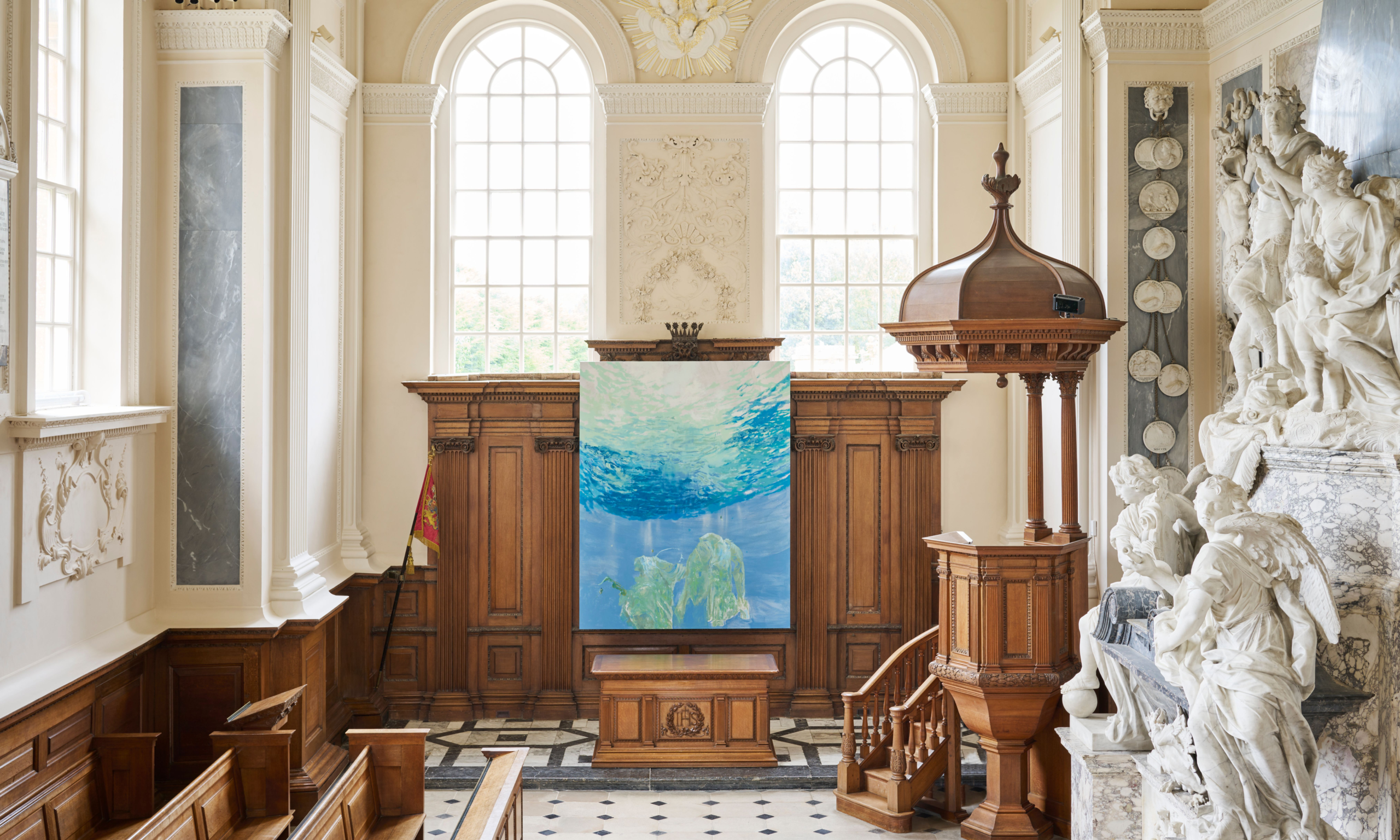Mohammed Sami Hiroshima Mon Amour, 2024. Installation view of ‘After the Storm: Mohammed Sami at Blenheim Palace’, Blenheim Palace, 2024. Photograph by Tom Lindboe. Courtesy of Blenheim Art Foundation.
The Iraqi artist Mohammed Sami, who grew up under the dictatorship of Saddam Hussein, is showing 14 new works in a solo exhibition at Blenheim Palace, the 18th-century stately home located in Oxfordshire, UK (After the Storm, 9 July-6 October).
The paintings were all made in response to the grandiose English estate that is the family seat of the dukes of Marlborough, and was the birthplace of the wartime prime minister Winston Churchill. One of the works, Immortality (2024), depicts Churchill, drawing on a celebrated photograph by the Armenian-Canadian photographer Yousuf Karsh. An accompanying caption says: “Hanging in the corridor alongside portraits of the Spencer Churchill family, Immortality is something of an anti-portrait, a redacted version of Karsh’s famous photograph in which its subject exists only as a shadow or fragment from our collective memory.”
Crucially, around 50 leaders from across Europe are expected to gather at the palace from 15-20 July for the European Political Community meeting, during which the site will be closed to the public. Figures including Sir Keir Starmer, the newly elected UK prime minister, and the French president Emmanuel Macron, will be able to browse Sami’s new body of works, some of which reflect on global conflicts.
The painting Chandelier (2024), which hangs in the Red Drawing Room, references warfare, with the trompe l’oeil image of a chandelier evoking a drone. The chipboard background meanwhile is reminiscent of abandoned buildings, but crucially, Sami includes the date of March 2003 – the start of the US-led invasion of Iraq.
The final work in the show, Hiroshima Mon Amour (2024), refers to the eponymous 1959 film by Alain Resnais which is set in Hiroshima, Japan, 14 years after it was devastated by an atomic bomb.
In a conversation with artist Rachel Whiteread featured in the exhibition catalogue, Sami discusses the work, saying: “I take the liberty of using conflicts other than the Middle East to examine how contemporary paintings deal with the weight of the past. The exhibition will not only be a presentation of cases of war but will also raise [the question of]… why can’t Mohammed, an Iraqi artist, mourn the tragedy of the victims of Hiroshima? Moreover, why can’t this be done in Churchill’s former home?”
In The Statues (2024), a number of objects are depicted wrapped in rolls of fabric, raising questions about what lies beneath the material. The title of the painting suggests they are public monuments possibly removed from display. But, in an interview with Whiteread, Sami says: “There is a good amount of delusion and trickery in the delivery of a painting that complicates the way a work operates visually… it might be true that I have seen dozens of bodies lying in Mesopotamian rivers.”
Meanwhile The Eastern Gate (2023), a vast panorama on view in the Saloon, shows Baghdad bathed in an orange light surrounded with a mosque on the skyline.
After the Storm is the ninth contemporary art exhibition to be held at the palace. Previous exhibitions have been dedicated to Yves Klein, Maurizio Cattelan, Michelangelo Pistoletto, Jenny Holzer, Ai Weiwei, Cecily Brown, Lawrence Weiner and Tino Sehgal. All of the exhibitions are organised by the Blenheim Art Foundation.
The Art Newspaper understands that all of the works will be returned to the artist when the show closes. Sami is represented by Modern Art gallery in London and Luhring Augustine in New York; the artist’s auction record stands at $952,500 (with fees), the price paid for The Praying Room (2021) which was sold at Sotheby’s New York last November.
After the Storm, Blenheim Palace, until 6 October

